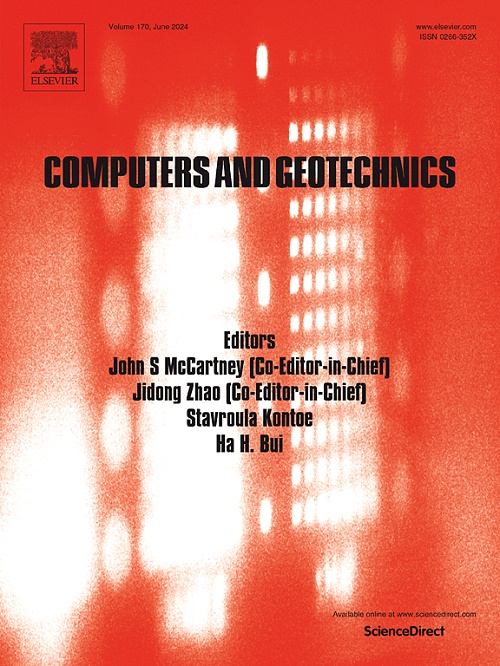Effects of mixed planting on stability of three-dimensional vegetated slope under extreme rainfall
IF 5.3
1区 工程技术
Q1 COMPUTER SCIENCE, INTERDISCIPLINARY APPLICATIONS
引用次数: 0
Abstract
To address the ecological restoration and slope stabilization needs, various plant species are utilized in soil bioengineering techniques. Existing studies consider only single-species due to lack of suitable modelling approach for hydro-mechanical reinforcements of individual species in a mixed-species condition. This study presents three-dimensional numerical analyses to investigate the hydrological response and stability of vegetated slopes under mixed planting conditions. A novel 3D numerical model is employed for simulating hydrological and mechanical reinforcements of different plant species, namely grass and shrub. Three series of numerical parametric studies are conducted: grass-only, shrub-only, and mixed grass-shrub planting conditions. The computed results illustrate that the factor of safety under mixed planting condition surpasses that of the shrub-only condition, primarily due to the amplified hydrological benefits. The interplay of plant spacing and mixed planting is also evident in 3D vegetated slopes. As plant spacing widens from 1 m to 3 m, the differences induced by mixed planting in retained suction following a 100-year extreme rainfall event significantly increase from 24 % to 75 %. The enhanced factor of safety resulting from the adoption of a mixed planting strategy escalates from 3 % to 16 %. Therefore, it is recommended that bioengineering designs for slope stabilization can incorporate mixed planting to reduce planting density.
极端降雨条件下混作对三维植被边坡稳定性的影响
为了满足生态恢复和边坡稳定的需要,各种植物物种被用于土壤生物工程技术。现有的研究只考虑单物种,因为缺乏合适的模拟方法来模拟混合物种条件下单个物种的水-机械增强。本文采用三维数值分析方法研究了混合种植条件下植被边坡的水文响应和稳定性。采用一种新颖的三维数值模型,模拟不同植物种类(草和灌木)的水文和机械增强。进行了三个系列的数值参数研究:纯草、纯灌木和草-灌木混合种植条件。计算结果表明,混种条件下的安全系数高于纯灌木条件,主要是由于水文效益的放大。植物间距和混作的相互作用在三维植被斜坡上也很明显。当株距从1 m加宽到3 m时,百年一变极端降水事件后混合种植的保留吸力差异从24%显著增加到75%。采用混合种植策略提高了安全系数,从3%上升到16%。因此,建议在边坡稳定的生物工程设计中加入混合种植,以降低种植密度。
本文章由计算机程序翻译,如有差异,请以英文原文为准。
求助全文
约1分钟内获得全文
求助全文
来源期刊

Computers and Geotechnics
地学-地球科学综合
CiteScore
9.10
自引率
15.10%
发文量
438
审稿时长
45 days
期刊介绍:
The use of computers is firmly established in geotechnical engineering and continues to grow rapidly in both engineering practice and academe. The development of advanced numerical techniques and constitutive modeling, in conjunction with rapid developments in computer hardware, enables problems to be tackled that were unthinkable even a few years ago. Computers and Geotechnics provides an up-to-date reference for engineers and researchers engaged in computer aided analysis and research in geotechnical engineering. The journal is intended for an expeditious dissemination of advanced computer applications across a broad range of geotechnical topics. Contributions on advances in numerical algorithms, computer implementation of new constitutive models and probabilistic methods are especially encouraged.
 求助内容:
求助内容: 应助结果提醒方式:
应助结果提醒方式:


